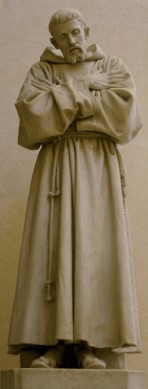Divine Providence can be interesting.
Yesterday as I was going through some holy cards I came across a card which I had found in an old Roman Breviary I had bought about ten years ago. The card was a list of prayers for the "Chair of Unity Octave of Intentions" and is from some time before 1968. I had never paid any attention to the card until I came across it yesterday and looked over it.
The interesting part is that today in my daily email from the Vatican Information Service, I got the prayers for the "Week of Prayer for Christian Unity." Looking over it I just began to wonder, "what the heck?"
"The theme chosen for this year's [2008] initiative, taken from the First Letter of Paul to the Thessalonians, is: "Pray without ceasing". The texts for reflection and prayer have been prepared by the Pontifical Council for Promoting Christian Unity and the Commission on Faith and Order of the World Council of Churches."
Here's the comparison of prayer intentions:
Week of Prayer for Christian Unity (2008).
19 January: Pray always, trusting God alone. "Give thanks in all circumstances" (1 Thessalonians 5, 18).
20 January: Pray without ceasing for the conversion of hearts. "Admonish the idlers, encourage the faint-hearted" (1 Thessalonians 5, 14).
21 January: Pray always for justice. "See that none of you repays evil for evil, but always seek to do good to one another and to all" (1 Thessalonians 5, 15).
22 January: Pray constantly with a patient heart. "Be patient with all of them" (1 Thessalonians 5, 14).
23 January: Pray always for grace to work with God. "Rejoice always, pray without ceasing" (1 Thessalonians 5, 16).
24 January: Pray for what we need. "... help the weak" (1 Thessalonians 5, 14).
25 January: Pray always that they all may be one. "Be at peace" (1 Thessalonians 5, 13b)
Chair of Unity Octave of Intentions (pre-1968)
January 18: The return of all the "other sheep" to the fold of St. Peter, the one shepherd.
January 19: The return of the Oriental Dissidents to Communion with the Apostolic See.
January 20: The Submission of Anglicans to the Authority of the Vicar of Christ.
January 21: That Lutherans and other Protestants of Contental Europe May Return to Holy Church.
January 22: That Christians in America may become one in Communion with the Chair of Peter.
January 23: That lapsed Catholics may return to the Sacraments.
January 24: The conversion of the Jews.
January 25: The Missionary conquest of the World for Christ.
Wow, the differences are just amazing. First off, it almost seems like there is such an effort to avoid anything traditional that we call the 8 days of prayer a "week" rather than an "octave." Last time I checked, a week was 7 days and an octave was 8.
Then there's just the lack of anything about Christian Unity in this year's intentions. They are just vague prayers about the Christian life, but there's nothing there about all Christians being united under Christ, His Church, and His Vicar. I mean, we might as well pray for rain and good harvests and it would help about as much as this years prayers for Christian Unity.
I know that everyone is touchy nowadays about a supposed triumphalism, but good grief, this is ridiculous. I think we have Dominus Iesus that would clearly support the more traditional intentions. It's not like we've abandoned the concept of the One Church. Even last year the Church re-iterated it with Responses To Some Questions Regarding Certain Aspects Of The Doctrine On The Church.
If we're going to pray for Christian unity, let's pray for Christian unity the way the Church teaches us to pray.
Here's the prayers for the Octave from the "Chair of Unity Octave Prayers"
Ant. That they all may be one as Thou Father in Me and I in Thee, that they also may be one in Us, that the world may believe that Thou hast sent me (Jn. 17:21).
V. I say unto thee that Thou art Peter.
R. And upon this rock I will build My Church.
Let us pray: O Lord Jesus Christ, who saidst unto Thine apostles: Peace I leave with you; My Peace I give unto you; regard not our sins, but the faith of Thy Church, and grant unto her that peace and unity which are agreeable to Thy Will. Who livest and reignest God forever and ever. Amen.
Lord Jesus, most gracious Saviour of the world, we humbly beg of Thee, by Thy most Sacred Heart, that all the sheep now wandering astry may be converted to Thee, the Shepherd and Bishop of their souls. Who livest and reignest through all eternity. Amen.
Our Lady of the Atonement, Mother of Unity, pray for us.
RS
Showing posts with label Church Triumphant. Show all posts
Showing posts with label Church Triumphant. Show all posts
Tuesday, January 15, 2008
Wednesday, October 03, 2007
Happy Transitus of Saint Francis
Today, October 3rd, is the celebration of the Transitus of Saint Francis. It may seem odd that we celebrate his feast day on October 4th, but this is because Saint Francis died after sundown on October 3rd, which in medieval times was the beginning of the next day. (The same logic applies to how we have vigils for Solemnities and Sundays)
Here's some pictures from my recent trip to Assisi a few weeks ago.
(As always, you can click on the pictures to get a better view)
Saint Francis died in the valley below Assisi, just outside the little chapel of Santa Maria degli Angeli (Our Lady of the Angels). Actually, now, there is a huge basilica built around the chapel.

This picture couldn't have been planned, right when I got off the bus and was taking this picture, a Franciscan Friar was walking in the perfect place.
The original chapel of Santa Maria degli Angeli is inside the basilica under the dome.

Even the inside of the chapel has a rugged beauty to it.

Saint Francis himself said "Our Lady and the Angels frequent this place." Hence the message on the floor at the entrance of the little chapel.

"HIC LOCUS SANCTUS EST" ("THIS PLACE IS HOLY").
Just behind the chapel and to the right is the little infirmary area where Saint Francis actually died. There is now a chapel inside the infirmary at the place where Saint Francis died.

"Qui mori S. Francesco 3 Ottobre 1226"
("Here Saint Francis died October 3rd, 1226")
On the outside of the infirmary is a beautiful painting of the death of Saint Francis called "The Transitus" by Domenico Bruschi.

I know the post is almost exactly the same as last year's, but I wanted to share some of the pictures I just took over there. I think they came out rather well given the lack of lighting. So, hope you enjoy them.
Sancte Francisce, ora pro nobis.
RS
Here's some pictures from my recent trip to Assisi a few weeks ago.
Saint Francis died in the valley below Assisi, just outside the little chapel of Santa Maria degli Angeli (Our Lady of the Angels). Actually, now, there is a huge basilica built around the chapel.

The original chapel of Santa Maria degli Angeli is inside the basilica under the dome.

Even the inside of the chapel has a rugged beauty to it.

Saint Francis himself said "Our Lady and the Angels frequent this place." Hence the message on the floor at the entrance of the little chapel.

Just behind the chapel and to the right is the little infirmary area where Saint Francis actually died. There is now a chapel inside the infirmary at the place where Saint Francis died.

("Here Saint Francis died October 3rd, 1226")
On the outside of the infirmary is a beautiful painting of the death of Saint Francis called "The Transitus" by Domenico Bruschi.

I know the post is almost exactly the same as last year's, but I wanted to share some of the pictures I just took over there. I think they came out rather well given the lack of lighting. So, hope you enjoy them.
Sancte Francisce, ora pro nobis.
RS
Labels:
Church art,
Church Triumphant,
Italy,
Religious Orders,
Saints
Monday, July 23, 2007
Signs of the Times
Kansas City Catholic has a new brilliant "dialogue" in a clever series. Go and check them out:
Signs: Street Talking
and an older one here:
Signs: Lenten Fare
RS
Signs: Street Talking
and an older one here:
Signs: Lenten Fare
RS
Labels:
catechesis,
Church Triumphant,
humor,
media,
pope,
scripture
Saturday, July 14, 2007
I've Been Sneaking Into China

Apparently, I have been able to sneak into China. When I check my sitemeter, I occasionally get hits from several places in China:

even though my website is supposedly blocked by the Chinese government.

My Catholic Chinese brethren must be laughing about it!

Our prayers are with you, Catholic brethren, keep the Faith!
RS
Labels:
Church Triumphant,
evangelization,
media,
politics,
teh internets
Monday, May 21, 2007
Saint Christopher Magallanes and Companions

Today is the Feast of Saint Chrisophter Magallanes and Companions.
Now, I have to admit, I had never heard of these Saints. And now I realized why. These Saints have only recently been raised to the altar by Pope John Paul II on May 21, 2000. And they were inserted into the universal calendar of the Church in the new 2002 edition of the Missale Romanum.
With a hat tip to Carolina Canonball over at The Crescat, I found out that Saint Christopher and Companions were a part of the Cristero rebellion in Mexico. This brings these Saints a little bit closer to home for me being in Texas and having a parishoner who has a great devotion to the Mexican Martyrs of the Cristeros rebellion, so much so that he taught himself Spanish just to be able to go to Mexico to learn more about the Cristeros. If you haven't heard of them, you might be more familiar with one of the more popular Martyrs of that movement, Blessed Miguel Pro.
I don't think many people realize that Mexico went through a Communist revolution and that the Catholic Church was suppressed to the point of the government putting priests and religious to death. Eventually the Cristeros formed and fought back against the government.
You can learn more about Saint Christopher (or Cristobal) Magallanes and Companions at Carolina Canonball's post and at the Patron Saint Index.
I also give a hat tip to Matt at Absolutely No Spin for bringing to my attention a Google Video about the Cristeros.
As a warning, there is a bit of foul language in it (subtitled). However, it gives a bit more history of some of the battles of the Cristeros and even covers the story of Saint Jose Sanchez del Rio, a young boy who was martyred during this time (and was canonized by Pope Benedict XVI on November 20, 2005).
RS
Labels:
Church Triumphant,
media,
politics,
Saints
Saturday, January 20, 2007
Feast of Pope Saint Fabian and Saint Sebastian
Today is the feast of Pope Saint Fabian, and Pope Saint Sebastian.
Although they are separate feasts liturgically, not only are they celebrated on the same day, but they are also venerated in the same place.
Now there is some ambiguity over where the remains of Pope Saint Fabian are. Some books say they are at the catacombs of Saint Callistus, although other books say his remains are at the church of the catacombs of Saint Sebastian.

There is a side chapel off to the right of the sanctuary which has a statue of Pope Saint Fabian, and some of his relics are either in the altar or buried beneath the floor of the chapel.

The catacombs below the church are named after Saint Sebastian who was originally buried in the catacombs. It is a rather extensive maze of tunnels. There is a "large" (compared to the tunnels) chapel in the place where Saint Sebastian's body was originally located. Eventually, a church was build above the catacombs and his body was moved to a side altar in the church which bears his name.

Another interesting relic on the other side of the church is one of the arrows which shot Saint Sebastian.

As I've mentioned earlier, it's really good to get to know the Saints. They can be very helpful, not only in their example, but also through their intercessions and guidance. Visiting tombs and seeing relics can really help you to gain a closeness to the Saints, even more than reading about them. I've been very blessed to be able to visit so many places in Rome and other parts of Italy as well. I would highly recommend that if you get an opportunity to make a pilgrimage you should take it.
My next desire is to make a pilgimage to the Holy Land.
RS
Although they are separate feasts liturgically, not only are they celebrated on the same day, but they are also venerated in the same place.
Now there is some ambiguity over where the remains of Pope Saint Fabian are. Some books say they are at the catacombs of Saint Callistus, although other books say his remains are at the church of the catacombs of Saint Sebastian.

There is a side chapel off to the right of the sanctuary which has a statue of Pope Saint Fabian, and some of his relics are either in the altar or buried beneath the floor of the chapel.

The catacombs below the church are named after Saint Sebastian who was originally buried in the catacombs. It is a rather extensive maze of tunnels. There is a "large" (compared to the tunnels) chapel in the place where Saint Sebastian's body was originally located. Eventually, a church was build above the catacombs and his body was moved to a side altar in the church which bears his name.

Another interesting relic on the other side of the church is one of the arrows which shot Saint Sebastian.

As I've mentioned earlier, it's really good to get to know the Saints. They can be very helpful, not only in their example, but also through their intercessions and guidance. Visiting tombs and seeing relics can really help you to gain a closeness to the Saints, even more than reading about them. I've been very blessed to be able to visit so many places in Rome and other parts of Italy as well. I would highly recommend that if you get an opportunity to make a pilgrimage you should take it.
My next desire is to make a pilgimage to the Holy Land.
RS
Saturday, January 06, 2007
San Carlo da Sezze

One of the few positive results about Epiphany being moved to the Sunday following January 6th is that today I can celebrate the feast of a good friend of mine, San Carlo da Sezze (Saint Charles of Sezze).
He's not a well known Saint outside of Italy, and from what I can gather outside of Sezze and Rome either.
He is another Saint I pretty much stumbled upon in Rome when I was visiting San Francesco a Ripa where is body is in a side altar.

I was just visiting the church because of my devotion to Saint Francis and this was one of the churches he would stay at in Rome.
I hear you can also visit San Carlo's cell at San Francesco a Ripa, but unfortunately I have never had any of the friars there be helpful in this. The sacristan would send me to the office, the office would send me to the sacristan (this is a textbook example of Italian bureaucracy, LOL). Thankfully his body is in the main church, so the only thing you have to worry about is if the church is open (and as most small churches in Italy, they do take siestas).
Although San Carlo was an uneducated lay-brother of the Franciscans, God gave him quite a spiritual insight and apparently wrote several books. He had a great devotion to Saint Theresa of Avila who was his inspiration and intercessor for spiritual knowledge.
He lived a very austere life and had a great love for the Blessed Sacrament. He even received the stigmata in the form of the wound in Christ's side when he devoutly prayed at the door of a church where the Blessed Sacrament was being exposed for adoration. A ray of light came forth from the Host and pierced his side. I believe the church was San Giuseppe a Capole Case if my research is correct, which is in the area between the Spanish Steps and the Trevi fountain in Rome.

San Carlo's writings are hard to find in English, but I did manage to obtain a copy of his autobiography. It is a fascinating book as it not only tells of his life, but also gives us a glimpse of Franciscan religious life back in the 1600's. Wow! Talk about penance and austerities.
I'm not sure why there are so many varying dates for his feast day. The current Roman Martyrology has his feast as today. I'm not sure why the patron saints index has his feast listed as tommorrow and I have even less understanding of why Butler's has him listed on January 10th. January 6th is the most reasonable since it is the day San Carlo died.
Anyway, I present another friend for you to get to know. As Pope John Paul II said, we must encourage a LIVED theology of the Saints. Go out and read some lives of the Saints, find one you like, and pray to them. They will help you out.
And if you can obtain a copy of San Carlo's autobiography, I highly encourage you to read it.

RS
Wednesday, November 29, 2006
Saint Saturninus
Today is the feast of a friend I "met" back in 2000 on my pilgrimage to Rome for the Holy Year. Thanks to Fr. Cassian of Norcia for the suggestion to visit the Basilica of Saints John and Paul.
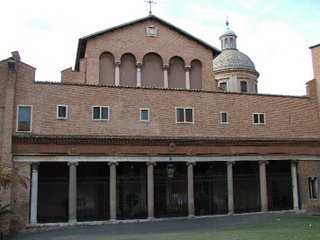
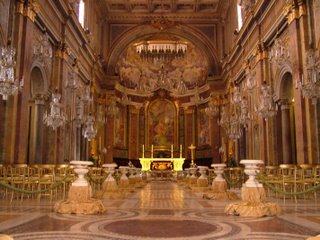 So, today is the feast of Saint Saturninus of Carthage (not to be confused with Saint Saturninus of Toulouse, a bishop and martyr in France, whose feast is also today). Not much is known about Saint Saturninus of Carthage, except what the Roman Martyrologies say (I use the plural since there is the "old" Roman Martyrology, a new Roman Martyrology was published in 2002, and then revised in 2004).
So, today is the feast of Saint Saturninus of Carthage (not to be confused with Saint Saturninus of Toulouse, a bishop and martyr in France, whose feast is also today). Not much is known about Saint Saturninus of Carthage, except what the Roman Martyrologies say (I use the plural since there is the "old" Roman Martyrology, a new Roman Martyrology was published in 2002, and then revised in 2004).
The old Roman Martyrology has this about Saint Saturninus:
The new (2004) Roman Martyrology has this:
Still, the fact of the matter is that Saint Saturninus was martyred in Rome and his remains are at a side altar at the Basilica of Saints John and Paul (the ones menioned in the Roman Canon). So, while visiting the Basilica, I developed a devotion to this martyr of old age.
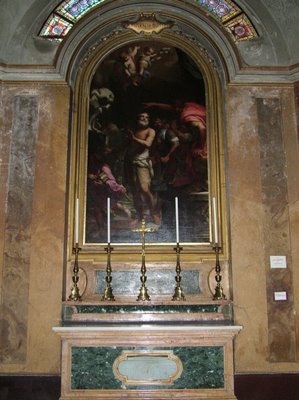 The sarcophagus in the altar used to have most of his relics, but the sacristan at the Basilica told me that a new parish was erected in Rome under his patronage and some of the remains were given to that parish.
The sarcophagus in the altar used to have most of his relics, but the sacristan at the Basilica told me that a new parish was erected in Rome under his patronage and some of the remains were given to that parish.
But I do love the painting above the altar.
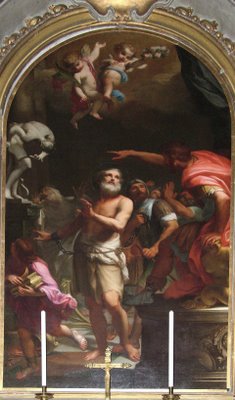 This Basilica has many great paintings and the remains of several saints:
This Basilica has many great paintings and the remains of several saints:
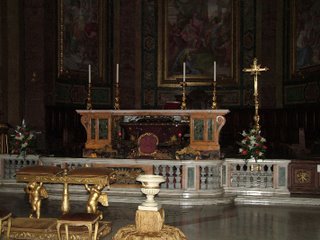
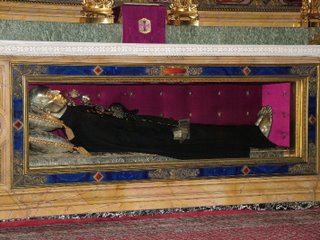


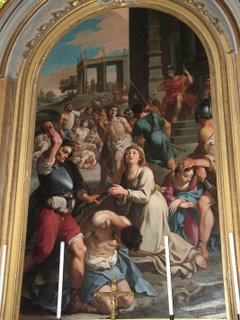
The Basilica is also very popular for weddings. It is near Saint Gregory the Great's church:
 which is catecorner from the Circus Maximus:
which is catecorner from the Circus Maximus:
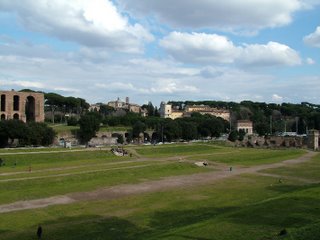
The Basilica of Saints John and Paul is definitely worth a visit if you are in Rome.
(And as always, you can click any of the pictures above to get a better view of them)
RS

 So, today is the feast of Saint Saturninus of Carthage (not to be confused with Saint Saturninus of Toulouse, a bishop and martyr in France, whose feast is also today). Not much is known about Saint Saturninus of Carthage, except what the Roman Martyrologies say (I use the plural since there is the "old" Roman Martyrology, a new Roman Martyrology was published in 2002, and then revised in 2004).
So, today is the feast of Saint Saturninus of Carthage (not to be confused with Saint Saturninus of Toulouse, a bishop and martyr in France, whose feast is also today). Not much is known about Saint Saturninus of Carthage, except what the Roman Martyrologies say (I use the plural since there is the "old" Roman Martyrology, a new Roman Martyrology was published in 2002, and then revised in 2004).The old Roman Martyrology has this about Saint Saturninus:
Romæ, via Salaria, natális sanctórum Mártyrum Saturnini senis, et Sisinii Diáconi, sub Maximiáno Príncipe; quos, diu in cárcere maceratos, jussit Urbis Præfectus in equuleum levári et attrahi nervis, fustibus ac scorpiónibus cædi, deínde eis flammas apponi, et, depositos de equuleo, cápite truncari.
At Rome, on the Salarian Way, the birthday of the holy martyr, Saturninus, an aged man, and the deacon Sisinius, in the time of Emperor Maximian. After a long imprisonment, by order of the prefect of the city they were placed on the rack, stretched with ropes, scourged with rods and whips garnished with metal, then exposed to the flames, taken down from the rack and beheaded.- from breviary.net's Roman Maryrology pages
The new (2004) Roman Martyrology has this:
Romæ in cœmetério Trasónis via Salária Nova, sancti Saturníni Carthaginénsis, mártyris, qui, ut sanctus Dámasus papa refert, sub Décio imperatóre pro Christo in pátria in ecúleo impósitus est et Romam extórris missus, ubi, áliis atrócibus torméntis superátis, Gratiánum tyránnum ad fidem convértit et cápite obtruncáto corónam martýrii adéptus est.(My rough translation)
At Rome, in the cemetary of Trasonis on the New Via Salaria, Saint Saturninus of Carthage, martyr, who, Pope Saint Damasus relates, that under the Emperor Decius, in his homeland he [St. Saturninus] was placed on the rack for Christ, and sent into exile in Rome, where, having overcome other severe tortures, converted the tyrant Gratianus to the faith, and [St. Saturninus] being beheaded obtained the crown of martyrdom.I'm not sure what happened to St. Saturninus' deacon companion Sisinius in the new Martyrology. I often worry that some parts of legends are automatically thrown out if they can't be proven, rather than keeping them until the can be proven false. That is often the case in the rather snotty comments in the Thurston & Atwater edition of Butler's Lives of the Saints.
Still, the fact of the matter is that Saint Saturninus was martyred in Rome and his remains are at a side altar at the Basilica of Saints John and Paul (the ones menioned in the Roman Canon). So, while visiting the Basilica, I developed a devotion to this martyr of old age.
 The sarcophagus in the altar used to have most of his relics, but the sacristan at the Basilica told me that a new parish was erected in Rome under his patronage and some of the remains were given to that parish.
The sarcophagus in the altar used to have most of his relics, but the sacristan at the Basilica told me that a new parish was erected in Rome under his patronage and some of the remains were given to that parish.But I do love the painting above the altar.
 This Basilica has many great paintings and the remains of several saints:
This Basilica has many great paintings and the remains of several saints:
Saints John and Paul

Saint Paul of the Cross

Saint Saturninus

Saint Pammachius (the one who built the Basilica and a friend of Saint Jerome)

and the Martyrs of Scillium.
The Basilica is also very popular for weddings. It is near Saint Gregory the Great's church:
 which is catecorner from the Circus Maximus:
which is catecorner from the Circus Maximus:
(Circus Maximus in the foreground, Church of Saint Gregory the Great to the right of the center of the picture, and Basilica of Saints John and Paul just to the left of the center of the pic.)
The Basilica of Saints John and Paul is definitely worth a visit if you are in Rome.
(And as always, you can click any of the pictures above to get a better view of them)
RS
Monday, November 13, 2006
Happy Benedictine All-Saints Day
Sunday, November 12, 2006
Feast of Saint Josaphat
Today is the feast of Saint Josaphat, a martyr for unity between the Church and the Eastern Orthodox.

Above is his tomb in Saint Peter's in Rome. Fittingly, it is one of the closest altars to Saint Peter's tomb.
I wish to commend Rod Dreher and any others who have left the Church for Eastern Orthodoxy to Saint Josaphat's prayers. It's also fitting that this feast is so near Pope Benedict's meeting with the patriarch in Turkey.
Sancte Josaphat, ora pro nobis.

Above is his tomb in Saint Peter's in Rome. Fittingly, it is one of the closest altars to Saint Peter's tomb.
I wish to commend Rod Dreher and any others who have left the Church for Eastern Orthodoxy to Saint Josaphat's prayers. It's also fitting that this feast is so near Pope Benedict's meeting with the patriarch in Turkey.
Sancte Josaphat, ora pro nobis.
Sunday, September 17, 2006
I Support The Pope
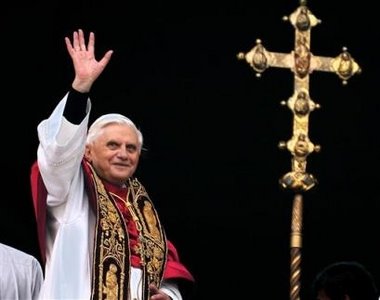
Just a quick blog for the evening.
Just saw a couple of banners which were made to show your support of Pope Benedict XVI on your blog or website.
The Curt Jester has a nice one.
And he also mentioned another over at Kenneth Kully's blog. I snagged his sidebar banner, but he also has a nicer topic banner too.
(I can't believe I figured out how to format it into the sidebar. w00t!)
UPDATE - You can click the "I Support The Pope" button to see what the Pope really said.
Labels:
blogging,
Church Triumphant,
pope,
radical Islam
Tuesday, June 27, 2006
The Church Shall Triumph
While surfing the other day I came across an entry at The Brussels Journal which suprised me.
It shows a late 17th century pulpit in the Church of Our Lady in Dendermonde, Flanders (Belgium).
The pulpit shows two Angels trampling a man who appears to be Mohammed.

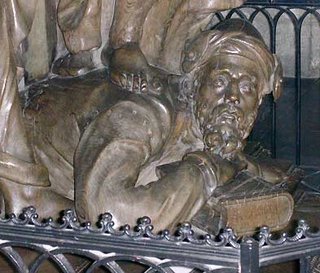
It reminds me of one of the statues in "Il Gesu" in Rome, the church where Saint Ignatius of Loyola is buried. The statue shows the Holy Mother Church throwing down who I believe are Luther and Calvin. Even a cherub is tearing the pages out of one of Luther's writings.

(click picuture for bigger version)
I've never had problems with a little triumphalism now and then. Fr. John Hardon defines it in his "Modern Catholic Dictionary" as, "A term of reproach leveled at the Catholic Church for the claim that she has the fullness of divine revelation and the right ot pass judgement on the personal and social obligations of humankind."
Certainly a triumphalistic approach is not going to work in certain situations of evangelization, but I often find that many Catholics are anti-triumphalistic to the point that they really don't believe that the Catholic Church contains the fullness of revelation. I find many Catholics who think that being Catholic is just one religion among equals. Other religious certainly participate in the Truth to some degree, ie the Orthodox have many of the same principles of faith and have valid Sacraments, many Protestants believe Jesus is Lord, Jews believe in God, etc. But none of these contain the fullness of God's revelation as the Catholic Church does.
I like to use a quote from Fr. Bill Casey, who is a Father of Mercy, when he was speaking about the struggle of the Church against the Devil. "I have read the Bible. I read the end ... and we win!"
Sounds triumphalistic, but if you believe in Christ and His Church, then you have to believe it is true. "The gates of Hell shall not prevail."
It shows a late 17th century pulpit in the Church of Our Lady in Dendermonde, Flanders (Belgium).
The pulpit shows two Angels trampling a man who appears to be Mohammed.


It reminds me of one of the statues in "Il Gesu" in Rome, the church where Saint Ignatius of Loyola is buried. The statue shows the Holy Mother Church throwing down who I believe are Luther and Calvin. Even a cherub is tearing the pages out of one of Luther's writings.

(click picuture for bigger version)
I've never had problems with a little triumphalism now and then. Fr. John Hardon defines it in his "Modern Catholic Dictionary" as, "A term of reproach leveled at the Catholic Church for the claim that she has the fullness of divine revelation and the right ot pass judgement on the personal and social obligations of humankind."
Certainly a triumphalistic approach is not going to work in certain situations of evangelization, but I often find that many Catholics are anti-triumphalistic to the point that they really don't believe that the Catholic Church contains the fullness of revelation. I find many Catholics who think that being Catholic is just one religion among equals. Other religious certainly participate in the Truth to some degree, ie the Orthodox have many of the same principles of faith and have valid Sacraments, many Protestants believe Jesus is Lord, Jews believe in God, etc. But none of these contain the fullness of God's revelation as the Catholic Church does.
I like to use a quote from Fr. Bill Casey, who is a Father of Mercy, when he was speaking about the struggle of the Church against the Devil. "I have read the Bible. I read the end ... and we win!"
Sounds triumphalistic, but if you believe in Christ and His Church, then you have to believe it is true. "The gates of Hell shall not prevail."
Subscribe to:
Posts (Atom)

